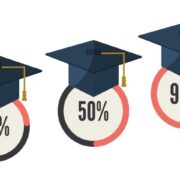College Application Deadlines – When Is It Due Anyway?
When a student starts to prepare their college applications, they may see some of these phrases thrown around: early action, early decision, rolling admissions, regular admission. What do these different college application deadlines mean? How do they impact your student as they get ready to hit the “send” button?
Parents, think back to when you applied for college. We probably did it on paper. Maybe we typed it? I remember using a pen and some white-out. Colleges had a due date when our applications had to be in and that was it. Easy and straightforward.
Today like just about every other aspect of the college application process, nothing is ever quite so cut and dried. Colleges may have more than one application deadline.
How do you know which applies to your student?
Early Decision – A Risky Gamble
Some colleges allow students to apply “early decision” (ED). Early decision is when your student raises their hand and says, “if accepted, ABC University is the one I want to attend.” ABC University knows they are the number one choice for that student.
If they accept that student, the student is required to withdraw applications from all other institutions to which they have applied. Applying ED is a binding contract between the student and the university. Students can only apply early decision to ONE institution.
Early decision application deadlines (as well as early action) will be earlier than the regular deadline. In essence, the student is asking to be looked at first, and they receive an answer about their acceptance before others.
Do not apply early decision unless you can afford to pay the FULL price at that school!!
Remember, if accepted, your student is contractually bound to attend the school, and you will not (likely) receive a full cost breakdown until well after you’ve been accepted. (Note – there is usually an out clause in the event the financial situation is not workable for the family. However, by the time you get that cost information, it’s spring of your senior year and many schools will no longer accept applications.)
Is applying ED worth it?
Depends on the school. Some schools show a preference to early decision candidates. At Davidson College, their class of 2024 had 656 early decision applicants of which 294 enrolled–so just under half of their ED applicants enrolled. Their overall acceptance rate was 20.3%. At the University of Pennsylvania, they received 6,453 early decision applications for the class of 2024. Just under 20% of those were accepted; however, those early decision students made up over 52% of the total class.
Before you plunge headlong into applying early action to Penn, consider this. The cost of attendance at Penn is over $83,000 per year. They don’t offer merit or athletic scholarships. Their aid is entirely need-based. If you qualify, great! If not, can you afford to pay full price? Maybe the early decision gamble is too risky?
Not all colleges use early decision as an application option. Ohio State University is one who does not use ED. How can you tell? If not clear on the university’s website, you might check www.CollegeData.com (a free login account is required) and navigate to the school’s admission tab. Here is Ohio State’s. You can see under “Early Decision Offered” it says “no.” When in doubt, always refer to the university for a specific answer.
More colleges may start offering incentives to ED applicants.
In Fall 2019, the National Association for College Admission Counselors (NACAC) removed restrictions from their code of ethics revolving around Early Decision. Colleges can now offer incentives like early housing choices to those who apply ED. Students beware! You could still end up paying full price. So, weigh the options carefully and understand what you are agreeing to.
Early Action – The Best of Both Worlds
Want to apply early but don’t want to bind yourself to one school? Your student can apply “early action” (EA). Early action is non-binding. If possible, we always recommend students apply by this earlier date which is usually November or December 1st. (Be sure to check the college’s website for the exact date!)
Like with ED, EA is a student’s chance to demonstrate their interest by applying early. Their application is reviewed first. They will receive notice of the school’s decision earlier.
Sometimes EA applicants will have a higher rate of admission than regular applicants, but this is not always true. In Ohio State’s case, their early action admission rate was 64%. Their overall admission rate was 54%.
The deadline for scholarship consideration is often (but not always!) the same as the early action deadline so getting that application and all its supporting material in on time is important to be considered for scholarships.
Some colleges make up their own terminology.
Terms like “restricted early action” or “restrictive early action” can show up for different colleges. They are all variations of the above with additional restrictions. Stanford has specific policies in place, and Notre Dame does too. They aren’t alone. Read the college’s information carefully so you understand their requirements.
Also note, some colleges may offer a second round of Early Decision and Early Action deadlines (EDII or EAII). These deadlines are typically in January/February. How are they used? Perhaps a student applied in the fall Early Decision but weren’t accepted, they could have a second chance to apply ED to a different college (since you are only allowed one ED at a time.) The Common App requirements grid is a quick way to look for these unusual deadlines.
Rolling Admission – Use It Right
Institutions with rolling admissions review each application as it is received. They say “yes” or “no” on each one and continue in this manner until all their available spots are filled up.
Benefits to rolling admission include early notification of acceptance (Ah! Stress gone!). Also, you can improve your chances of application by submitting earlier than others.
Be careful not to fall into the trap of “YAY! No deadline!” Spots will fill up so don’t wait too long and submit your application after everyone else.
Because you may get an earlier response from a rolling admission school, you may not have the answers back from other colleges you applied to. The rolling admission school could possibly ask for you to decide before you have heard from the other possibilities.
Regular Admission – Gives Your Student Time
The regular admission deadline is probably around January or February 1st. (Again, check that website!) Choosing regular admission gives a student more time to complete their application. Students who are borderline academically also have more time to demonstrate they are working hard and improving during their senior year.
If applying regular admission, be sure your senior does not get lazy around the holidays in December with those January due dates. A mad scramble makes for a miserable senior year.
Also, students must avoid severe cases of senioritis that first semester. Colleges regularly ask for the student’s grades after the first semester regardless of the type of admission option they choose.
Depending on the student, the benefit of applying early and getting that massive weight off their shoulders far outweighs the benefit of having more time. So, pay careful attention to those college application deadlines, apply early, and enjoy your senior year.
Originally published 10/2017
Updated 10/2019
Update 9/2020
Update 7/2021
Enjoy this post? Don’t want to miss any future blogs about education, college, or careers?











